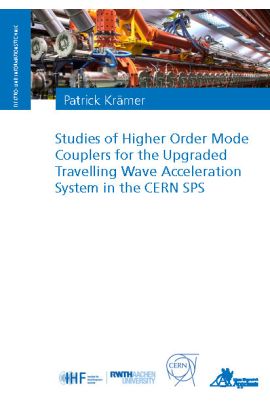Future high energy particle physics research based on accelerators requires high beam intensity. Parasitic interaction of the charged particle beam with its environment can deteriorate the beam quality and limit the peak intensity for which safe machine operation can be ensured. The beam induces electromagnetic fields in the accelerator components surrounding it which in turn affect the particle motion and can lead to beam instabilities. This interaction is typically described by the concept of beam coupling impedance.
At CERN, the Large Hadron Collider relies on a pre-accelerator chain which is presently upgraded to ensure delivery of the demanding high intensity proton beam required in the future. The Super Proton Synchrotron is the last pre-accelerator and utilises a travelling wave system for acceleration to a proton energy of 450GeV. The travelling wave structures of this broadband acceleration system are cylindrical waveguides periodically loaded with drift-tubes and stems. One main obstacle for higher beam intensity in the SPS is presently a multi-bunch instability which is triggered by higher order standing wave modes around 630MHz in these accelerating structures. The beam coupling impedance of these modes is already heavily damped by resistive higher order mode couplers, but particle-tracking simulations suggest that additional impedance mitigation by a factor of three in the ideal case can cure the instability for the beam intensity required in the future.
The goal of this thesis is to identify and characterise the deteriorating higher order modes and to significantly improve on the present impedance mitigation. The improvement is achieved most notably by a revision of the existing HOM coupler and a newly developed mitigation technique that consists of subtle changes in the accelerating structure. The practical feasibility of the proposed improvements is imperative and the impact on the fundamental accelerating mode must stay within acceptable limits. In this regard, a broad understanding of the acceleration system is required and therefore also developed throughout this thesis. The proposed solutions for achieving the increased damping are developed by theoretical analysis together with electromagnetic simulations and their performance is validated by RF measurements. Measurements are also used to quantify in unprecedented detail the impact of the numerous higher order mode mitigation devices on the available fundamental accelerating voltage.
| Autor | Krämer, Patrick |
|---|---|
| Lieferzeit | 3-4 Tage |
| Gewicht | 0.246 kg |
| Erscheinungsdatum | 12.08.2020 |
Elektro- und Informationstechnik
Studies of Higher Order Mode Couplers for the Upgraded Travelling Wave Acceleration System in the CERN SPS
Kurzbeschreibung
The thesis contributes to the future operation of the Super Proton Synchrotron at CERN and to the numerous efforts that ensure the long-term physics performance of the Large Hadron Collider. An increased mitigation of higher order electromagnetic modes in the travelling wave acceleration system of the SPS is required to ensure delivery of the high intensity particle beam desired in the future. The proposed solutions are developed from theory as well as simulations and tested in measurements.

